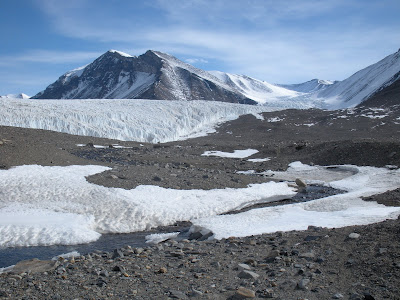Prof anxious to return to Antarctica for scientific mission
Priscu Research Group
John Priscu, second from right, is one of three leaders of a $10 million, six-year research project on the Whillans Ice Stream in Antarctica. Priscu, a Montana State University professor of environmental sciences, has pioneered the study of cold climates over the past 10 years. The 2009 field team for one of his projects included Tristy Vick, Andrew Baber, Priscu and Amy Chiuchiolo (our new friends!)
After more than 10 years of pushing the science of icy worlds, John Priscu has finally defrosted his critics.
Having just returned from Antarctica, Priscu restlessly halted long enough to talk about his latest and largest project so far — the $10 million Whillans Ice Stream Subglacial Access Research Drilling project, or WISSARD.
The three-pronged study will look at microorganisms that live in Lake Whillans, thousands of feet under the ice, as well as use a remote robot to explore the area between the ice sheets and the ocean.
It’s a big expedition. The six-year scientific mission, funded by the National Science Foundation, will involve 13 principal investigators, including Priscu, and nine institutions. Since Priscu helped develop the field of study, he is one of three leaders. He estimated that the logistics of moving people and equipment into the field will cost NSF another $40 million, a small chunk of the agency’s $9.5 billion 2009 budget.
“What’s neat about WISSARD is it’s actually an opportunity to crack through to those lakes and find out what’s in there,” said Dana Cruikshank of the National Science Foundation.
He noted that it’s like an international race, with the British and Russians pursuing the same goals, yet cooperative. He added that the research has big implications for climate science.
“We’ll get a better idea of how quickly the ice sheet is moving into the ocean,” Cruikshank said.
Piece of the pie
About $2.7 million of the $10 million will be directed to MSU’s piece of the puzzle, called GBASE, or GeomicroBiology of Antarctic Subglacial Environments.
Priscu said GBASE will be looking for novel organisms that have learned to survive for millions of years under the Antarctic ice sheet without sunlight.
“There has never been a sample from the bottom of an ice sheet collected for microorganisms,” Priscu said.
The other two acronym-loaded components of the project are LISSARD, Lake and Ice Stream Subglacial Access Research Drilling, and RAGES, Robotics Access to Grounding-Zones for Exploration.
LISSARD will take measurements from Lake Whillans, after drilling 2,300 feet through the ice to the water body. Scientists will measure water pressure and other variables to determine how often the lake fills and floods.
In RAGES, a robot will be lowered into the water to examine the area where the 100-mile long Whillans Ice Stream meets the Ross Ice Shelf to measure the stream’s velocity and how quickly it’s wearing away the ice.
“The U.S. project is by far the most integrated,” Priscu said.
Field work will begin next year, including the testing of the $4 million hot-water drill that has its own purifying system to insure that no contaminants enter the 1-foot drill holes.
Unlike Priscu, UC Santa Cruz professor Andy Fisher, an oceanographer, will be making his first trip to Antarctica as one of the researchers.
His project will be to examine how much geothermal heat from the earth is warming the base of the ice cap. The heat has never been measured before, leaving a gap in calculating about how fast the ice cap may melt.
Why go?
There are several reasons the research is important, Priscu said.
• The Antarctic ice sheet is half again as large as the United States. It contains 70 percent of the world’s fresh water. Should it melt, the Statue of Liberty would be waist-deep in water and many of the major metropolitan areas around the world would be underwater. The ice sheet produces so much water as it now melts that it rivals the Amazon River for contributing water and nutrients to the ocean.
• The ice sheets also harbor a record of the Earth’s climate. Air bubbles trapped in the ice go back 1 million years. The ice also reflects the sun’s heat away from Earth; if it were gone, the planet would be a warmer place.
• The cold environment also offers testing grounds for work on other planets, where ice may harbor extraterrestrial life. There’s also the possibility that newly discovered microorganisms might provide chemicals for medicines as well as insight into how they survive repeated freezing and thawing cycles.
“It’s like a last frontier of life,” Priscu said, “Instead of Antarctica being a big dead place, ice is an oasis for life.”




















